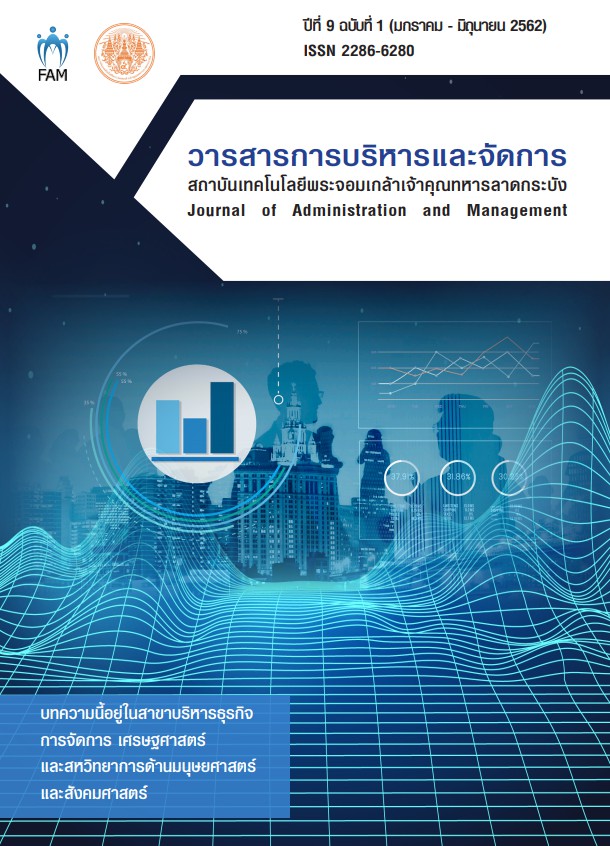ACCEPTANCE IN USING ELECTRONIC PAYMENT SYSTEM OF WORKING PEOPLE IN THE CENTRAL REGION, THAILAND
Main Article Content
Abstract
Electronic payment is a type of technology system that plays a significant role in the current economic system. This research aimed to study the level of acceptance of using electronic payment systems of working people groups gathered data by choosing the central region of Thailand. The objective was to study the level of electronic payment systems acceptance by demographic factors among working people groups in the central region of Thailand. There were 400 samples for this research which was used the independent samples t-test and One-Way ANOVA analytic methods. The analysis results found that for the working-age with different gender accepted of electronic payment systems, there were no significant differences in opinions. Indicated by differences in education, occupation and average of net income at least one (1) pair of significance was found from the testing assumption. Grouping with income levels more than 45,001 baht with the level of acceptance of electronic payments is significantly different from the group with an income level below or equal to 15,000 baht significantly at the level of 0.05. This research might be more beneficial to particular institutions, financial institutions, in using information to develop a system with speed and safety in receiving and paying of electronic payment systems.
Article Details
Journal of KMITL Business School is available both online and in printed version.
**All articles or opinions presented in this issue of the Journal of KMITL Business School reflect the thoughts of their respective authors. This journal serves as an independent platform for a variety of viewpoints. Authors bear full responsibility for the content of their articles.**
**All articles published in this journal are copyrighted by KMITL Business School, King Mongkut's Institute of Technology Ladkrabang. The editorial team permits copying or using articles, but a reference to the journal is required.**
References
เกศวิทู ทิพยศ. 2557. ปัจจัยที่มีอิทธิพลต่อการตัดสินใจใช้บริการธุรกรรมทางการเงินผ่านสื่อออนไลน์ กรณีศึกษา ธนาคาร ซีไอเอ็มบีไทย จำกัด (มหาชน). การค้นคว้าอิสระ. บริหารธุรกิจบัณฑิต. มหาวิทยาลัยเนชั่น.
จินดา แก้วแทน. 2557. ปัจจัยที่มีผลต่อการยอมรับการใช้บริการชำระเงินทางอิเล็กทรอนิกส์ผ่านอุปกรณ์สมาร์ตโฟน : กรณีศึกษาในพื้นที่กรุงเทพมหานครและปทุมธานี. การค้นคว้าอิสระ. บริหารธุรกิจมหาบัณฑิต. มหาวิทยาลัยธรรมศาสตร์.
จรุมาส ชัยถิรสกุล และณักษ์ กุลิสร์. 2555. ปัจจัยที่มีผลต่อพฤติกรรมการใช้พาณิชย์อิเล็กทรอนิกส์ ของผู้ใช้บริการอินเทอร์เน็ต. วารสารบริหารธุรกิจศรีนครินทรวิโรฒ.
ชวิศา พุ่มดนตรี. 2559. ปัจจัยที่ส่งผลต่อการยอมรับการใช้บริการพร้อมเพย์ (Prompt Pay) ของประชาชนในเขตกรุงเทพมหานครและปริมณฑล.การค้นคว้าอิสระ. บริหารธุรกิจมหาบัณฑิต. มหาวิทยาลัยธรรมศาสตร์.
ชานนท์ ศิริธร. 2554. การเปิดรับสื่อและการยอมรับนวัตกรรมของผู้บริโภคเจเนอเรชั่น เอ็กซ์ และเจเนอเรชั่นวาย. วิทยานิพนธ์มหาวิทยาลัยจฬาลงกรณ์มหาวิทยาลัย.
ธนาคารแห่งประเทศไทย.ข้อมูลจำนวนรายการการชำระเงินผ่านระบบ e-payment. [ออนไลน์], https://www.bot.or.th. วันที่สืบค้น 12 กรกฎาคม 2561.
ธนาคารกสิกรไทย จำกัด (มหาชน). รายงานประจำปี 56-1. [ออนไลน์], https://www. online.kasikornbankgroup.com. วันที่สืบค้น 11 กรกฎาคม 2561.
นงลักษณ์ วิรัชชัย. 2553. สถิติวิเคราะห์เชิงปริมาณ. กรุงเทพมหานคร: โรงพิมพ์ มหาวิทยาลัยสุโขทัยธรรมาธิราช.
บังอรรัตน์ สำเนียงเพราะ. 2554. ปัจจัยที่ผลต่อการยอมรับและพฤติกรรมการใช้งานเทคโนโลยีสำนักงานเสมือน กรณีศึกษา: หน่วยงานปฏิบัติการภาคสนามองค์กรผู้ให้บริการ โทรศัพท์เคลื่อนที่. การค้นคว้าอิสระ. วิทยาศาสตร์มหาบัณฑิต. มหาวิทยาลัยธรรมศาสตร์.
ปฐวี ฉลวย สิงหะ ฉวีสุข และ ณฐพล พันธุวงศ์. 2558. การประยุกต์ใช้ทฤษฎีรวมการยอมรับการใช้ เทคโนโลยี (UTAUT) และส่วนขยายทฤษฎีรวมการยอมรับการใช้เทคโนโลยี (UTAUT2) กับการทำธุรกรรมทางอิเล็กทรอนิกส์. วารสารเทคโนโลยีสารสนเทศลาดกระบัง.
วอนชนก ไชยสุนทร. 2558. การยอมรับการใช้งานของระบบการชำระเงินแบบอิเล็กทรอนิกส์ ในประเทศไทย. ทุนสนับสนุนงานวิจัยจากเงินรายได้ ประจำปีงบประมาณ พ.ศ. 2558. สถาบันเทคโนโลยีพระจอมเกล้าเจ้าคุณทหารลาดกระบัง.
ศนิ อนันต์รัตนโชติ. 2553. ปัจจัยที่ส่งผลต่อการยอมรับเทคโนโลยีการชำระเงินผ่านเว็บไซต์ (Web Payment) ของผู้ซื้อสินค้าและบริการออนไลน์. การค้นคว้าอิสระ. วิทยาศาสตร์มหาบัณฑิต. มหาวิทยาลัยธรรมศาสตร์.
สราวุธ ควชะกุล และ ไกรชิต สุตะเมือง. 2557. ความไว้วางใจในการบริการธนาคารออนไลน์ของผู้บริโภคในเขตกรุงเทพมหานคร. วารสารการเงิน การลงทุน การตลาด และการบริหารธุรกิจมหาวิทยาลัยรังสิต.
สายชล สินสมบูรณ์ทอง. 2560. สถิติเบื้องต้น.กรุงเทพมหานคร: จามจุรีโปรดักท์.
สิงหะ ฉวีสุข และ สุนันทา วงศ์จตุรภัทร. 2012. ทฤษฏีการยอมรับการใช้เทคโนโลยีสารสนเทศ. วารสารเทคโนโลยีสารสนเทศลาดกระบัง.
สำนักงานพัฒนาธุรกรรมอิเล็กทรอนิกส์. E-payment. [ออนไลน์], https://www.etda.or.th. วันที่สืบค้น 11 กรกฎาคม 2561.
Junadi Sfenrianto (2015). “A Model of Factors Influencing Consumer’s Intention To Use E- Payment System in Indonesia” Journal of Procedia Computer Science. 59: 214-220
Pei-Chun Lin (2009). “Perceived usefulness, ease of use, and usage of citation database interfaces: a replication” Journal of The Electronic Library. 27(1). 31-42.
R. Ryan Nelson and Peter A. Todd (1992). “Perceived Usefulness Ease of Use, and Usage of Information Technology: A Replication” Journal of MIS Quarterly. 16 (2). 227-247.
Wendy Ming-Yen Teoh (2013). Factors affecting consumers’ perception of electronic payment: an empirical analysis. Research paper. Business and Law. Multimedia University, Melaka, Malaysia.


